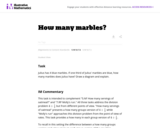
This task addresses the division problem 4Ö1/3.
- Subject:
- Mathematics
- Numbers and Operations
- Material Type:
- Activity/Lab
- Provider:
- Illustrative Mathematics
- Provider Set:
- Illustrative Mathematics
- Author:
- Illustrative Mathematics
- Date Added:
- 09/14/2012

This task addresses the division problem 4Ö1/3.
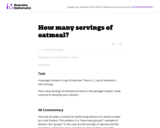
This task provides a context for performing division of a whole number by a unit fraction. This problem is a "How many groups?'' example of division.
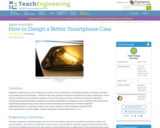
Engineers create and use new materials, as well as new combinations of existing materials to design innovative new products and technologies—all based upon the chemical and physical properties of given substances. In this activity, students act as materials engineers as they learn about and use chemical and physical properties including tessellated geometric designs and shape to build better smartphone cases. Guided by the steps of the engineering design process, they analyze various materials and substances for their properties, design/test/improve a prototype model, and create a dot plot of their prototype testing results.
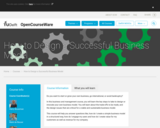
Do you want to start or grow your own business, go international, or avoid bankruptcy?
In this business and management course, you will learn the key steps to take to design or innovate your own business model. You will learn about the trade-offs to be made, and the design issues that are critical for a viable and sustainable business model.
This course will help you answer questions like, how do I create a simple business model in a structured way, how do I engage my users and how do I create value for my customers as well as revenue for my company.
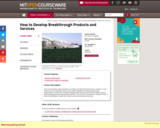
Firms must develop major innovations to prosper, but they don't know how to. However, recent research into the innovation process has made it possible to develop breakthroughs systematically. 15.356 How to Develop Breakthrough Products and Services explores several practical idea generation development methods. To convey the art required to implement each of these methodologies, experts are invited to present real cases to the class.
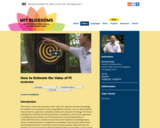
This lesson is about the estimation of the value of Pi. Based on previous knowledge, the students try to estimate Pi value using different methods, such as: direct physical measurements; a geometric probability model; and computer technology. This lesson is designed to stimulate the learning interests of students, to enrich their experience of solving practical problems, and to develop their critical thinking ability. To understand this lesson, students should have some mathematic knowledge about circles, coordinate systems, and geometric probability. They may also need to know something about Excel. To estimate Pi value by direct physical measurements, the students can use any round or cylindrical shaped objects around them, such as round cups or water bottles. When estimating Pi value by a geometric probability model, a dartboard and darts should be prepared before the class. You can also use other games to substitute the dart throwing game. For example, you can throw marbles to the target drawn on the floor. This lesson is about 45-50 minutes. If the students know little about Excel, the teacher may need one more lesson to explain and demonstrate how to use the computer to estimate Pi value. Downloadable from the website is a video demonstration about how to use Excel for estimating Pi.
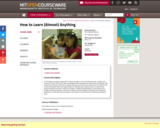
Examines how new computational tools and activities can help people learn new things in new ways. Discusses theories of learning and education underlying the design and use of these tools, and explores how new tools can change the ways people think about learning and education. Special emphasis on "constructionist" approaches to learning (represented by tools such as StarLogo and programmable LEGO bricks). Final project involves the design and observation of learning activities. As the digital revolution brings with it radical changes in how and what we learn, people must continue to learn all the time. New technologies make possible new approaches to learning, new contexts for learning, new tools to support learning, and new ideas of what can be learned. This course will explore these new opportunities for learning with a special focus on what can be learned through immersive, hands-on activities. Students will participate in (and reflect on) a variety of learning situations, and will use Media Lab technologies to develop new workshops, iteratively run and refine the workshops, and analyze how and what the workshop participants learn.
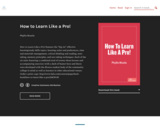
How to Learn Like a Pro! features the “big six” effective learning/study skills topics:
- Learning styles and preferences
- Time and materials management
- Critical thinking and reading
- Note-taking
- Memory principles and techniques
- Test-taking
Each of the six units featuring a total of twenty-three lessons and accompanying exercises (with a dash of humor here and there) were developed with the diverse student body of the community college in mind as well as learners in other educational venues.

Provides a hands-on introduction to the resources for designing and fabricating smart systems, including CAD/CAM/CAE; NC machining, 3-D printing, injection molding, laser cutting; PCB layout and fabrication; sensors and actuators; analog instrumentation; embedded digital processing; wired and wireless communications. Emphasis on learning how to use the tools as well as understand how they work.
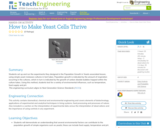
Students set up and run the experiments they designed in the Population Growth in Yeasts associated lesson, using simple yeast-molasses cultures in test tubes. Population growth is indicated by the amount of respiration occurring in the cultures, which in turn is indicated by the growth of carbon dioxide bubbles trapped within the culture tubes. Using this method, students test for a variety of environmental influences, such as temperature, food supply and pH.
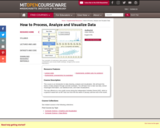
This course is an introduction to data cleaning, analysis and visualization. We will teach the basics of data analysis through concrete examples. You will learn how to take raw data, extract meaningful information, use statistical tools, and make visualizations. This was offered as a non-credit course during the Independent Activities Period (IAP), which is a special 4-week term at MIT that runs from the first week of January until the end of the month.

Students measure and analyze forces that act on vehicles pulling heavy objects while moving at a constant speed on a frictional surface. They study how the cars interact with their environments through forces, and discover which parameters in the design of the cars and environments could be altered to improve vehicles' pulling power. This LEGO® MINDSTORMS® based activity is geared towards, but not limited to, physics students.

The growing body of online educational resources is helping to create universal access to language education. This is a good thing. Use this introductory guide to find open resources for your classroom. The OER ecosystem works best when everybody contributes content. Consider sharing your own. Educators often supplement foreign language textbooks. Perhaps your students need more grammar, authentic L2 materials, or listening practice exercises. Go to an open content search page. For example, Creative Commons offers a system of open licensing which enables resource sharing. Their CC search page is a great place to start. However, finding openly licensed educational resources (OER)—which can be edited, built upon, and shared without copyright restrictions—isnʼt always easy.
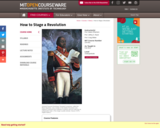
This course explores fundamental questions about the causes and nature of revolutions. How do people overthrow their rulers? How do they establish new governments? Do radical upheavals require bloodshed, violence, or even terror? How have revolutionaries attempted to establish their ideals and realize their goals? We will look at a set of major political transformations throughout the world and across centuries to understand the meaning of revolution and evaluate its impact. By the end of the course, students will be able to offer reasons why some revolutions succeed and others fail. Materials for the course include the writings of revolutionaries, declarations and constitutions, music, films, art, memoirs, and newspapers.

The single most important skill for a computer scientist is problem solving. The goal of this book is to teach you to think like a computer scientist.

Python is a fun and extremely easy-to-use programming language that has steadily gained in popularity over the last few years. Developed over ten years ago by Guido van Rossum, Python's simple syntax and overall feel is largely derived from ABC, a teaching language that was developed in the 1980's. However, Python was also created to solve real problems and it borrows a wide variety of features from programming languages such as C++, Java, Modula-3, and Scheme. Because of this, one of Python's most remarkable features is its broad appeal to professional software developers, scientists, researchers, artists, and educators. 278 page pdf file.
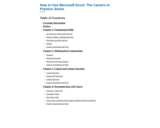
How to Use Microsoft Excel: The Careers in Practice Series is an textbook appropriate for a course covering Microsoft Excel at a beginner to intermediate level. It is geared toward and will be accommodating for students and instructors with little to no experience in using Microsoft Excel. However, the approach is not at the expense of relevance.
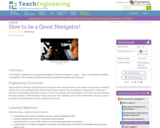
In this lesson, students will learn how great navigators of the past stayed on course that is, the historical methods of navigation. The concepts of dead reckoning and celestial navigation are discussed.
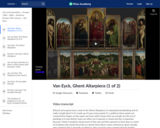
This art history video discussion looks at Jan (and Hubert?) Van Eyck's "Ghent Altarpiece or The Adoration of the Mystic Lamb", tempera and oil on panel, (closed panels), Cathedral of Saint Bavo, Ghent, Belgium, completed 1432. Second Life correspondents Max Newbold and Sez Zabelin, discuss the closed Ghent Altarpiece (see the next video for a discussion of the open altarpiece) on the Vassar campus in Second Life.
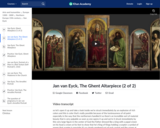
This art history video is the second part of the discussion about Jan (and Hubert?) Van Eyck's "Ghent Altarpiece or The Adoration of the Mystic Lamb", tempera and oil on panel, (open panels), Cathedral of Saint Bavo, Ghent, Belgium, completed 1432.